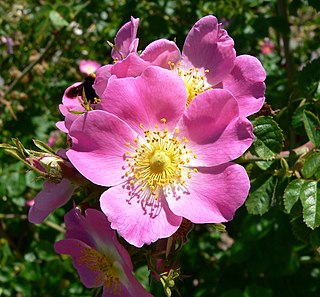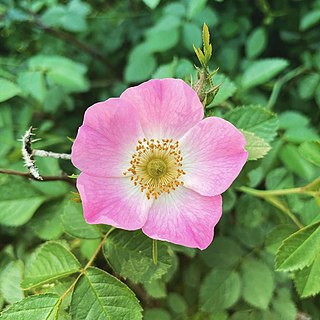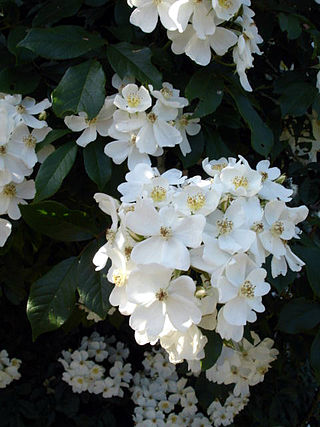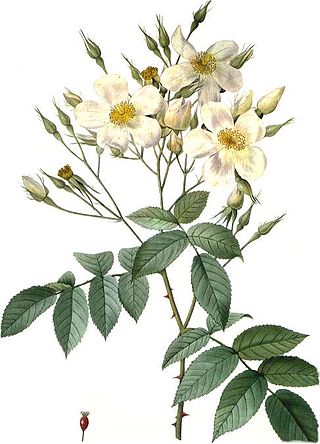
A rose is either a woody perennial flowering plant of the genus Rosa, in the family Rosaceae, or the flower it bears. There are over three hundred species and tens of thousands of cultivars. They form a group of plants that can be erect shrubs, climbing, or trailing, with stems that are often armed with sharp prickles. Their flowers vary in size and shape and are usually large and showy, in colours ranging from white through yellows and reds. Most species are native to Asia, with smaller numbers native to Europe, North America, and Northwest Africa. Species, cultivars and hybrids are all widely grown for their beauty and often are fragrant. Roses have acquired cultural significance in many societies. Rose plants range in size from compact, miniature roses to climbers that can reach seven meters in height. Different species hybridize easily, and this has been used in the development of the wide range of garden roses.

Campsis radicans, the trumpet vine, yellow trumpet vine, or trumpet creeper, is a species of flowering plant in the trumpet vine family Bignoniaceae, native to eastern North America, and naturalized elsewhere. Growing to 10 metres, it is a vigorous, deciduous woody vine, notable for its showy trumpet-shaped flowers. It inhabits woodlands and riverbanks, and is also a popular garden plant.

Rosa laevigata, the Cherokee rose, is a white, fragrant rose native to southern China, Taiwan and Vietnam. It is an invasive species in countries including Australia, Japan and the United States.

Rosa rugosa is a species of rose native to eastern Asia, in northeastern China, Japan, Korea and southeastern Siberia, where it grows on beach coasts, often on sand dunes. It is naturalized in much of Europe and parts of the United States and Canada. It should not be confused with Rosa multiflora, which is also known as "Japanese rose". The Latin word "rugosa" means "wrinkled", referring to the wrinkled leaves. Often used as an ornamental plant, it has become invasive in parts of Europe, North America and South America.

Rosa multiflora is a species of rose known commonly as multiflora rose, baby rose, Japanese rose, many-flowered rose, seven-sisters rose, Eijitsu rose and rambler rose. It is native to eastern Asia, in China, Japan, and Korea. It should not be confused with Rosa rugosa, which is also known as "Japanese rose", or with polyantha roses which are garden cultivars derived from hybrids of R. multiflora. It was introduced to North America, where it is regarded as an invasive species.

Rosa canina, the dog rose, is a variable climbing, wild rose species native to Europe, northwest Africa, and western Asia.

Rosa rubiginosa is a species of rose native to Europe and western Asia.

Rosa 'Schoener's Nutkana' is a deep pink rose variety named after Father Georg Schöner (1864–1941), a priest who became a notable rose breeder, who developed this rose in 1930 as a cross between Rosa nutkana and the hybrid perpetual 'Paul Neyron'.

Rosa chinensis, known commonly as the China rose, Chinese rose, or Bengal rose, is a member of the genus Rosa native to Southwest China in Guizhou, Hubei, and Sichuan Provinces. The first publication of Rosa chinensis was in 1768 by Nikolaus Joseph von Jacquin in Observationum Botanicarum, 3, p. 7 & plate 55.

Rosa acicularis is a flowering plant in the Rosaceae family. It is commonly known as the prickly wild rose, prickly rose, bristly rose, wild rose or Arctic rose. It is a species of wild rose with a Holarctic distribution in northern regions of Asia, Europe, and North America.

Rosa filipes is a species of flowering plant in the rose family Rosaceae, native to western China, in Gansu, Shaanxi, Sichuan, Xizang, and Yunnan.

Rosa carolina, commonly known as the Carolina rose, pasture rose, or prairie rose, is a perennial shrub in the rose family native to eastern North America. It can be found in nearly all US states and Canadian provinces east of the Great Plains. It is common throughout its range and can be found in a wide variety of open habitats, from thickets and open woods to roadsides and along railroads.

Rosa moschata, the musk rose, is a species of rose which has been long in cultivation. Its wild origins are uncertain but are suspected to lie in the western Himalayas.

Rosa gymnocarpa is a species of rose native to western North America. It is known by the common names dwarf rose, baldhip rose, and wood rose. It grows in shady, damp, and rich forests.

Rosa'Veilchenblau' is a mauve hybrid multiflora rose cultivar and the best known violet rambler. Other names are 'Bleu-Violet', 'Blue Rambler', 'Blue Rosalie' and 'Violet Blue'.

Rosa bridgesii is a species of rose known by the common names pygmy rose and Sierran dwarf rose. It is native to California, where it grows in the forests of the Sierra Nevada and surrounding mountains and foothills. It may also occur in Oregon.

Rosa woodsii is a species of wild rose known by the common names Woods' rose, interior rose, common wild rose, mountain rose, pear-hip rose, and prairie rose.

Garden roses are predominantly hybrid roses that are grown as ornamental plants in private or public gardens. They are one of the most popular and widely cultivated groups of flowering plants, especially in temperate climates. An enormous number of garden cultivars has been produced, especially over the last two centuries, though roses have been known in the garden for millennia beforehand. While most garden roses are grown for their flowers, often in dedicated rose gardens, some are also valued for other reasons, such as having ornamental fruit, providing ground cover, or for hedging.

Rosa 'Nevada' is a white climbing rose cultivar developed by Pedro Dot in Spain in 1927. It is one of his most successful creations and is named for its colour, as nevada is the Spanish word for "snowy". Its parentage was long under discussion, as Dot introduced the cultivar as a hybrid moyesii, but the cultivar's round, black hips point to its R. pimpinellifolia-parentage. It is probably a cross between Dot's pink hybrid tea 'La Giralda' and the wild rose species Rosa pimpinellifolia var. altaica, but is sometimes still described as a hybrid moyesii.

Rosa nitida, also known as the shining rose due to its glossy leaves, is a perennial species in the plant genus Rosa in the plant family Rosaceae. It is native to northeastern North America, from Connecticut north to Newfoundland and Quebec. It forms a low, suckering, deciduous shrub, growing up to a metre in height, although often less. Its stems are thin and covered in fine bristles. Its pinnate leaves have 7 to 9 shining leaflets which turn bright red, yellow and purple in the fall. Its small pink flowers appear in summer and are subtly but sweetly scented, smelling like Convallaria ("Lily-of-the-Valley"). They are followed by small, round, red hips.





















